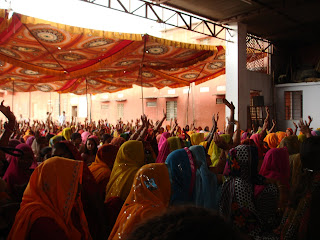Last Friday myself and my new colleagues (some students from the US) spent the day on a field visit, way away from our office, in the Chaksu district of Rajasthan. One of the microfinance organisations I've been studying was holding it's 4th Annual General Meeting, so we went along to see some of the actual impact of the organisation on it's members. Not knowing what to expect, I ended up having one of my best days here so far - the entire event was incredible.
There were over 550 women from rural villages attending - they in turn represented 145 autonomous Self-Help Groups who actually make up this particular microfinance organisation. The picture below is of me with the president of the organisation, who absolutely kicks ass - she's been in the organisation since it started 15 years ago, knows and is trusted implicitly by seemingly all of the women in the organisation (around 1,600), runs everything and everyone like clockwork and has had such a huge impact on the lives of women across the district that a few years ago she was flown to the White House to meet the President.
There were over 550 women from rural villages attending - they in turn represented 145 autonomous Self-Help Groups who actually make up this particular microfinance organisation. The picture below is of me with the president of the organisation, who absolutely kicks ass - she's been in the organisation since it started 15 years ago, knows and is trusted implicitly by seemingly all of the women in the organisation (around 1,600), runs everything and everyone like clockwork and has had such a huge impact on the lives of women across the district that a few years ago she was flown to the White House to meet the President.
We arrived early morning in the middle of a downpour - which didn't do much to dampen the atmosphere - and got to light the ceremonial lamp to mark the start of the meeting! The event was a really nice way to see what a huge difference the organisation has made in the area. The basic operation involves establishing small, local self help groups of women who save money together, and allowing them to borrow small sums of money (providing the only alternative that doesn't involve an extortionately high-interest lender; needless to say in rural areas the majority don't possess the kind of capital required for a traditional bank loan), that they can use to fund income-generating activities such as handicrafts or agricultural work. This model has been well tested (and proven) throughout Asia and the rest of the world as a way to substantially improve the quality of life of rural families - because they work with, and effectively borrow from their neighbours people are very committed to the self help groups. The loan default rate is around 1%.
I'd argue though that the economic benefits are actually topped by the social impact that's come from economically empowering the women (and it is only for women - again and again this has been shown to be the most effective way to ensure repayment, and ensure the money goes into families). Rajasthan is famously very traditional in outlook - whilst it's amazing to see such an old culture being well preserved and blended in with modern life, it often means that in rural areas opportunities for women and girls are all too few. The ongoing dowry system financially cripples families, who thus devote few other resources to females (sadly more advanced pre-natal screening also means that there is an increasingly high incidence of female foeti being electively and sometimes forcibly aborted). There is a low literacy rate amongst rural females, who are often married early and without any means of earning are entirely dependent on their husbands or families. Some families still practice purdah, whereby married women are required to veil their whole face in the presence of men other than their husband - as several parts of the same family often live together this can mean that even at home a woman has to cover up, to avoid her father-in-law or brothers-in-law seeing her face. This is much more common in rural areas but even in Jaipur the practice exists, although it's difficult to see how widespread it is as obviously the women rarely venture outdoors.
Therefore giving the women here the opportunity to make a small independent income is only the tip of the iceberg - contributing to the household generally automatically improves their standing and treatment, as well as allowing investment in things like education for their families. Needless to say it's also a huge self-confidence booster, particularly as the organisation regularly run skills-building workshops teaching the women basic leadership skills, and the knowledge needed to run small enterprises. Finally, because there are so many members involved in the organisation (1,600) they've started to exercise increasing levels of influence with local government and policy makers, people that individually the members wouldn't ever have a chance of accessing.
In short, the day was completely inspirational. It was also special as I haven't had much of a change to interact with Indian women other than the women I live with, which is a real shame. Women mainly stay at home, so it's easy to look down a street here without seeing a single female face (which can feel eerily lonely), and even if I do by chance meet women, unless they're from the educated middle class it's quite rare for them to have much English. I'll definitely remember it as one of my favourite days of the whole trip - more photos of voting and dancing below!






No comments:
Post a Comment